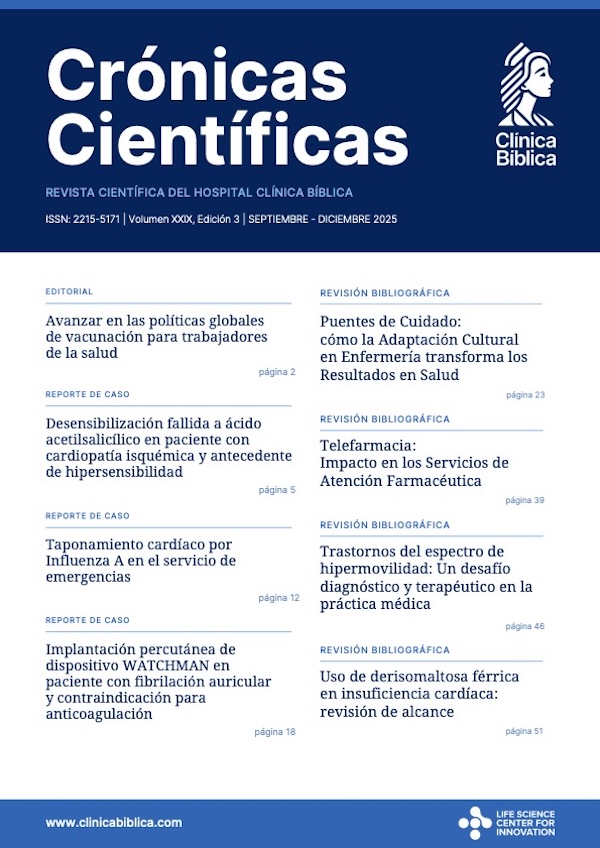- Visto: 1066
Revisión bibliográfica
Sangrado intestinal
Intestinal bleeding
Edición VIII Enero - Abril 2018
DOI: https://doi.org/10.55139/TBKX9408
APA (7ª edición)
Guerra, D., Buckcanan, A. (2018). Sangrado intestinal. Crónicas científicas, 8(8), 6-8. https://doi.org/10.55139/TBKX9408.
Vancouver
Guerra D, Buckcanan A. Sangrado intestinal. Cron cient. 2018;8(8):6-8.
Dra. Deybrin Guerra
Médico general, EBAIS Galenos, Hospital Clínica Bíblica.
Miembro del Colegio de Médicos y Cirujanos de Costa Rica.
Costa Rica.
Dr. Aldair Buckcanan
Médico interno, Escuela de Medicina, UCIMED.
Miembro del Colegio de Médicos y Cirujanos de Costa Rica.
Costa Rica.
Resumen
La hemorragia digestiva es una patología que se asocia a condiciones que amenazan la vida con severidad. Se define según su relación con el ligamento de Treitz en sangrado digestivo alto o bajo. Las causas más frecuentes de un sangrado digestivo alto son enfermedad ácido-péptica, Mallory – Weiss, gastritis por estrés, dielafoy y el variceal. El origen de un SDB es primordialmente debido a diverticulosis, enfermedad anorrectal, isquemia, enfermedad inflamatoria intestinal, entre otras entidades. La mortalidad de esta condición se debe a una causa de base así como comorbilidades del paciente. La estabilización inicial y la reanimación de los pacientes son imperativas para definir el abordaje posterior.
Palabras claves
Treitz, hematoquecia, melena, diverticulitis, úlcera gástrica, várices esofágicas, endoscopía, transfusión.
Abstract
The digestive hemorrhage is a pathology that is associated with conditions that threaten life with severity. It is defined according to its relation to the ligament of Treitz in high or low digestive bleeding. The most frequent causes of a high digestive bleeding are acid-peptic disease, Mallory-Weiss, stress gastritis, dielafoy, and variceal. The origin of an SDB is primarily due to diverticulosis, anorectal disease, ischemia, inflammatory bowel disease, among other entities. The mortality of this condition is due to a base cause as well as patient comorbidities. Initial stabilization and resuscitation of patients are imperative to define the posterior approach.
Keywords
Treitz, hematochezia, mane, diverticulosis, gastric ulcer, esophage varices, endoscopy, transfusion.
Bibliografía
Douglas, F.; Gerardo, C.; Tran, T.; Fisher, D. (2012, 14 de marzo). Does this patient have a severe upper gastrointestinal bleed? Journal of American Medical Association. 307(10), 1072-79.
Feinman M, Haut E. (2014). Lower gastrointestinal bleeding. Surgery Clinics of North America. 94, 55-63.
Feinman M, Haut E. (2014). Upper gastrointestinal bleeding. Surgery Clinics of North America. 94, 45-53.
Gralnek, I.; Barkun, A.; Bardou, M. (2008, 28 de agosto). Management of acute bleeding from peptic ulcer. New England Journal of Medicine. 359, 928-37.
Gralnek, I.; Neeman, Z.; Strate, L. (2017, 16 de marzo). Acute lower gastrointestinal bleeding. New England Journal of Medicine. 376, 1054-63.Pilotto, A.; Maggi, S.; Noale, M. et al. (2010). Development and validation of a new questionnaire for the evaluation of upper gastrointestinal symptoms in the elderly population: a multicenter study. J Gerontol A Biol Sci Med Sci. 65(2), 174–8.
Prieto, B. ;Fernández, A.; Acosta, R. (2012). Protocolo diagnóstico de la hemorragia digestiva de origen oscuro. Protocolos de práctica asistencial. Medicine. 11(6), 394-7.
Sugawa, C.; Benishek, D.; Walt, A.J. (1983). Mallory-Weiss syndrome. A study of 224 patients. Am J Surg. 145(1), 30–3.
Sung, J.J.; Tsoi, K.K.; Ma, T.K. et al. (2010). Causes of mortality in patients with peptic ulcerbleeding: a prospective cohort study of 10 428 cases. Am J Gastroenterol. 105(1), 84–9.
Udel, J. et al. (2012, 22-29 de febrero). Does this patient with liver disease have cirrhosis? Journal of American Medical Association. 307(8), 832-842.
APA (7ª edición)
Guerra, D., Buckcanan, A. (2018). Sangrado intestinal. Crónicas científicas, 8(8), 6-8. https://doi.org/10.55139/TBKX9408.
Vancouver
Guerra D, Buckcanan A. Sangrado intestinal. Cron cient. 2018;8(8):6-8.
Esta obra está bajo una licencia internacional Creative Commons: Atribución-NoComercial-CompartirIgual 4.0 Internacional (CC BY-NC-SA 4.0)

Realizar búsqueda
Última Edición
Ediciones Anteriores






